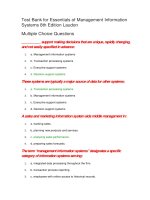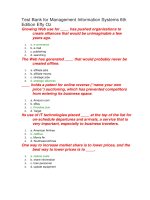Enterprise manage information systems 6th by laudon ch01
Bạn đang xem bản rút gọn của tài liệu. Xem và tải ngay bản đầy đủ của tài liệu tại đây (613.79 KB, 50 trang )
Chapter 1
Essentials of Management Information Systems, 6e
Chapter 1 Managing the Digital Firm
Managing the Digital Firm
1.1
© 2005 by Prentice Hall
Essentials of Management Information Systems, 6e
Chapter 1 Managing the Digital Firm
Objectives
1. What is the role of information systems in
today’s competitive business environment?
2. What exactly is an information system?
What do managers need to know about
information systems?
3. How are information systems transforming
organizations and management?
1.2
© 2005 by Prentice Hall
Essentials of Management Information Systems, 6e
Chapter 1 Managing the Digital Firm
Objectives
4. How have the Internet and Internet
technology transformed business and
government?
5. What are the major management
challenges to building and using information
systems?
1.3
© 2005 by Prentice Hall
Essentials of Management Information Systems, 6e
Chapter 1 Managing the Digital Firm
Management Challenges
1. Design competitive and effective systems.
2. Understand system requirements of global
business environment.
3. Create information architecture that supports
organization’s goal.
1.4
© 2005 by Prentice Hall
Essentials of Management Information Systems, 6e
Chapter 1 Managing the Digital Firm
Management Challenges
4. Determine business value of information
systems.
5. Design systems people can control,
understand and use in a socially, ethically
responsible manner.
1.5
© 2005 by Prentice Hall
Essentials of Management Information Systems, 6e
Chapter 1 Managing the Digital Firm
Why Information Systems?
The Competitive Business Environment and the Emerging Digital Firm
Four powerful worldwide changes that have
altered the business environment:
1.
2.
3.
4.
1.6
Globalization
Rise of the Information Economy
Transformation of the Business Enterprise
Emergence of the Digital Firm
© 2005 by Prentice Hall
Essentials of Management Information Systems, 6e
Chapter 1 Managing the Digital Firm
Why Information Systems?
The Competitive Business Environment and the Emerging Digital Firm
Globalization
•
•
•
•
1.7
Management and control in a global
marketplace
Competition in world markets
Global workgroups
Global delivery systems
© 2005 by Prentice Hall
Essentials of Management Information Systems, 6e
Chapter 1 Managing the Digital Firm
Why Information Systems?
The Competitive Business Environment and the Emerging Digital Firm
Rise of the Information Economy
•
•
•
•
•
•
•
1.8
Knowledge- and information-based economies
New products and services
Knowledge: a central productive and strategic asset
Time-based competition
Shorter product life
Turbulent environment
Limited employee knowledge base
© 2005 by Prentice Hall
Essentials of Management Information Systems, 6e
Chapter 1 Managing the Digital Firm
Why Information Systems?
The growth of the information economy
Figure 1-1
1.9
© 2005 by Prentice Hall
Essentials of Management Information Systems, 6e
Chapter 1 Managing the Digital Firm
Why Information Systems?
The Competitive Business Environment and the Emerging Digital Firm
Transformation of the Business Enterprise
•
•
•
•
•
•
•
1.10
Flattening
Decentralization
Flexibility
Location independence
Low transaction and coordination costs
Empowerment
Collaborative work and teamwork
© 2005 by Prentice Hall
Essentials of Management Information Systems, 6e
Chapter 1 Managing the Digital Firm
Why Information Systems?
Information technology capital investment 1980-2003
Figure 1-2
1.11
© 2005 by Prentice Hall
Essentials of Management Information Systems, 6e
Chapter 1 Managing the Digital Firm
Why Information Systems?
The Competitive Business Environment and the Emerging Digital Firm
Emergence of the Digital Firm
•
•
•
•
1.12
Digitally enabled relationships with customers,
suppliers, and employees
Core business processes accomplished via
networks
Digital management of key corporate assets
Rapid sensing and responding to environmental
changes
© 2005 by Prentice Hall
Essentials of Management Information Systems, 6e
Chapter 1 Managing the Digital Firm
Why Information Systems?
What Is an Information System?
A set of interrelated components that collect
(or retrieve), process, store, and distribute
information to support decision making and
control in an organization
1.13
© 2005 by Prentice Hall
Essentials of Management Information Systems, 6e
Chapter 1 Managing the Digital Firm
Why Information Systems?
What Is an Information System?
• Data:
Streams of raw facts representing events such as business transactions
• Information:
1.14
Clusters of data that are meaningful and useful to human beings
© 2005 by Prentice Hall
Essentials of Management Information Systems, 6e
Chapter 1 Managing the Digital Firm
Why Information Systems?
Data and information
Figure 1-3
1.15
© 2005 by Prentice Hall
Essentials of Management Information Systems, 6e
Chapter 1 Managing the Digital Firm
Why Information Systems?
Functions of an information system
Figure 1-4
1.16
© 2005 by Prentice Hall
Essentials of Management Information Systems, 6e
Chapter 1 Managing the Digital Firm
Why Information Systems?
What Is an Information System?
Formal Systems
•
•
Fixed definitions of data and procedures for
collecting, storing, processing, disseminating,
and using these data
Can be computer-based or manual
Computer-based Information Systems
•
1.17
Use computer hardware and software to
process and disseminate information
© 2005 by Prentice Hall
Essentials of Management Information Systems, 6e
Chapter 1 Managing the Digital Firm
Why Information Systems?
Window on Technology
UPS Competes Globally with
Information Technology
•
•
•
•
1.18
What are the inputs, processing, and outputs of
UPS’s package tracking system?
What technologies are used?
How are these technologies related to UPS’s
business strategy? How do they provide value
for the company?
What would happen if these technologies were
not available?
© 2005 by Prentice Hall
Essentials of Management Information Systems, 6e
Chapter 1 Managing the Digital Firm
Why Information Systems?
The business information value chain
Figure 1-5
1.19
© 2005 by Prentice Hall
Essentials of Management Information Systems, 6e
Chapter 1 Managing the Digital Firm
Why Information Systems?
Information systems are more than computers
Figure 1-6
1.20
© 2005 by Prentice Hall
Essentials of Management Information Systems, 6e
Chapter 1 Managing the Digital Firm
Why Information Systems?
A Business Perspective on Information Systems
• Information systems literacy: Broad-based
understanding of information systems that includes
behavioral knowledge about organizations and
individuals using information systems and technical
knowledge about computers
• Computer literacy: Knowledge about
information technology, focusing on understanding
how computer-based technologies work
1.21
© 2005 by Prentice Hall
Essentials of Management Information Systems, 6e
Chapter 1 Managing the Digital Firm
Why Information Systems?
A Business Perspective on Information Systems
Major Business Functions
•
•
•
•
•
1.22
Sales and marketing
Manufacturing
Finance
Accounting
Human resources
© 2005 by Prentice Hall
Essentials of Management Information Systems, 6e
Chapter 1 Managing the Digital Firm
Why Information Systems?
A Business Perspective on Information Systems
Key Elements of an Organization
•
•
•
•
•
1.23
People
Structure
Operating Procedures
Politics
Culture
© 2005 by Prentice Hall
Essentials of Management Information Systems, 6e
Chapter 1 Managing the Digital Firm
Why Information Systems?
A Business Perspective on Information Systems
Management Levels
•
•
•
1.24
Senior managers: make long-range strategic
decisions about products and services
Middle managers: carry out the programs
and plans of senior management
Operational managers: monitor the firm’s
daily activities
© 2005 by Prentice Hall
Essentials of Management Information Systems, 6e
Chapter 1 Managing the Digital Firm
Why Information Systems?
A Business Perspective on Information Systems
Information Technology (IT) Infrastructure
•
•
•
•
1.25
Computer hardware
Computer software
Storage technology
Communications technology
© 2005 by Prentice Hall









